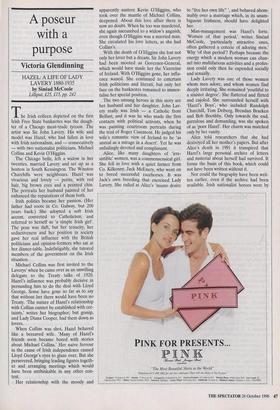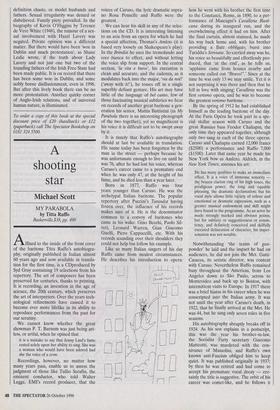A poseur with a purpose
Victoria Glendinning
HAZEL: A LIFE OF LADY LAVERY 1880-1935 by Sinead McCoole Lilliput, f25, .E15, pp. 242
he Irish colleen depicted on the first Irish Free State banknotes was the daugh- ter of a Chicago meat-trade tycoon. The artist was Sir John Lavery. His wife and model was Hazel, who had fallen in love with Irish nationalism, and — consecutively — with two nationalist politicians, Michael Collins and Kevin O'Higgins.
The Chicago belle, left a widow in her twenties, married Lavery and set up as a hostess in South Kensington. The Winston Churchills were neighbours. Hazel was vivacious and lovely — petite, with red hair, big brown eyes and a pointed chin. The portraits her husband painted of her enhanced the reputations of them both.
Irish politics became her passion. (Her father had roots in Co. Galway, but 200 years back.) She adopted a soft Irish accent, converted to Catholicism, and referred to herself as 'a simple Irish girl'. The pose was daft, but her tenacity, her seductiveness and her position in society gave her real influence with the British politicians and opinion-formers who sat at her dinner-table. Indefatigably, she tutored members of the government on the Irish situation.
Michael Collins was first invited to the Laverys' when he came over as an unwilling delegate to the Treaty talks of 1920. Hazel's influence was probably decisive in persuading him to do the deal with Lloyd George. Some have gone so far as to say that without her there would have been no Treaty. 'The nature of Hazel's relationship with Collins cannot be established with cer- tainty,' writes her biographer; but gossip, and Lady Diana Cooper, had them down as lovers.
When Collins was shot, Hazel behaved like a bereaved wife. 'Many of Hazel's friends soon became bored with stories about Michael Collins.' Her naive fervour in the cause of Irish independence caused Lloyd George's eyes to glaze over. But she persevered, bringing leading figures togeth- er and arranging meetings which would have been unthinkable in any other con- text.
Her relationship with the moody and apparently austere Kevin O'Higgins, who took over the mantle of Michael Collins, deepened. About this love affair there is now no doubt. When he too was murdered, she again succumbed to a widow's anguish, even though O'Higgins was a married man. She circulated his love letters, as she had Collins's.
With the death of O'Higgins she lost not only her lover but a dream. Sir John Lavery had been mooted as Governor-General, which would have made her the Vicereine of Ireland. With O'Higgins gone, her influ- ence waned. She continued to entertain Irish politicians and literati, but only her face on the banknotes remained to immor- talise her special position.
The two unsung heroes in this story are her husband and her daughter. John Lav- ery really was Irish — a Catholic from Belfast; and it was he who made the first contacts with political activists, when he was painting courtroom portraits during the trial of Roger Casement. He judged his wife's romantic view of Ireland to be 'as unreal as a mirage in a desert'. Yet he was unfailingly devoted and complaisant.
Alice, like many daughters of 'irre- sistible' women, was a commonsensical girl. She fell in love with a quiet farmer from Co. Kilkenny, Jack McEnery, who went on to breed successful racehorses. It was Jack's own breeding that exercised Lady Lavery. She railed at Alice's 'insane desire to "live her own life" ', and behaved abom- inably over a marriage which, in its unam- biguous Irishness, should have delighted her.
Man-management was Hazel's forte. `Women of that period,' writes Sinead McCoole, 'particularly attractive ones, often gathered a coterie of adoring men.' Why 'of that period'? Perhaps because the energy which a modern woman can chan- nel into multifarious activities and a profes- sion could only then be expended socially and sexually.
Lady Lavery was one of those women whom men adore, and whom women find deeply irritating. She remained 'youthful to a sinister degree'. She flattered and flirted and cajoled. She surrounded herself with `Hazel's Boys', who included Randolph Churchill, Tom Driberg, Brendan Bracken and Bob Boothby. Only towards the end, garrulous and demanding, was she spoken of as 'poor Hazel'. Her charm was matched only by her vanity.
Alice told researchers that she had destroyed all her mother's papers. But after Alice's death in 1991 it transpired that Hazel's large personal archive of letters and material about herself had survived. It forms the basis of this book, which could not have been written without it.
Nor could the biography have been writ- ten earlier, even if the archive had been available. Irish nationalist heroes were by definition chaste, or model husbands and fathers. Sexual irregularity was denied or disbelieved. Family piety prevailed. In the biography of Kevin O'Higgins by Terence de Vere White (1948), the rumour of a sex- ual involvement with Hazel Lavery was negated. Private opinion was a different matter. But there would have been 'woe in Dublin and much protestation', as Shane Leslie wrote, if the truth about Lady Lavery and not just one but two of the founding fathers of the Irish Free State had been made public. It is on record that there has been some woe in Dublin, and some nobly borne disillusionment, even in 1996. But after this lively book there can be no more protestation. Another quirky corner of Anglo-Irish relations, and of universal human nature, is illuminated.
To order a copy of this book at the special discount price of £20 (hardback) or £12 (paperback) call The Spectator Bookshop on 0181 324 5500.



















































































 Previous page
Previous page